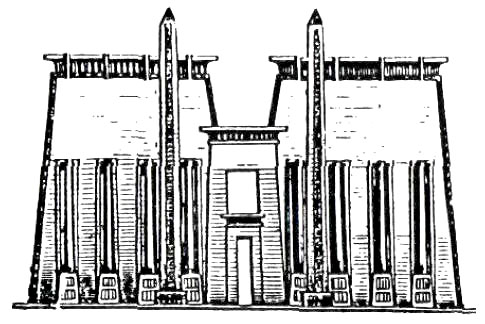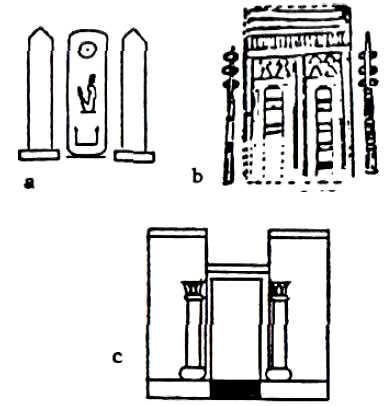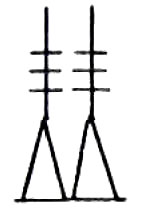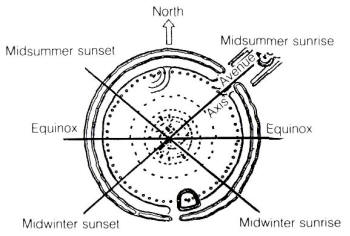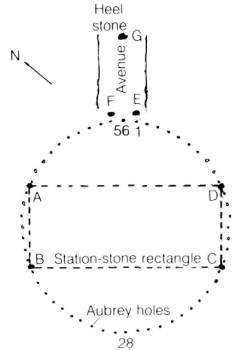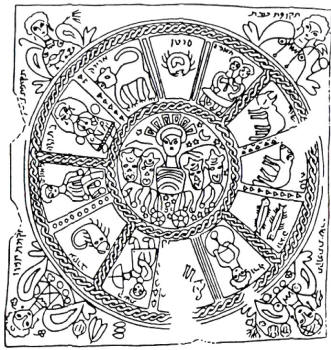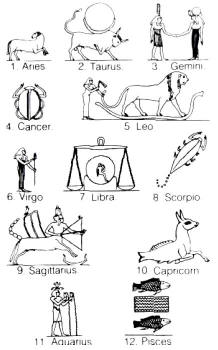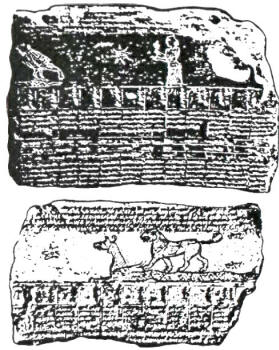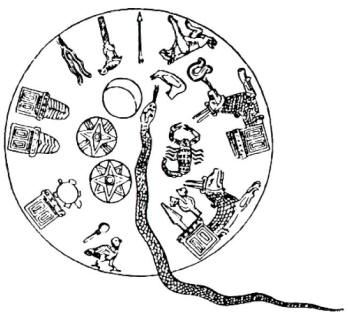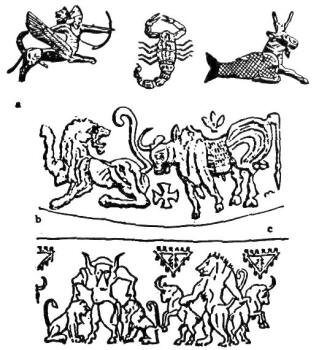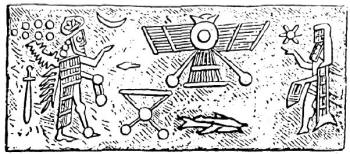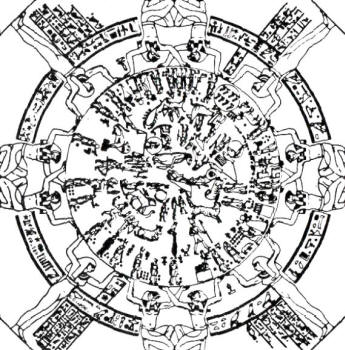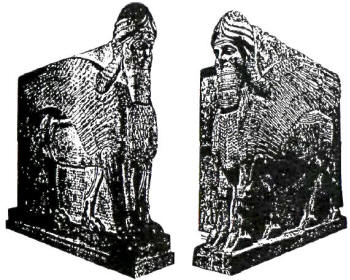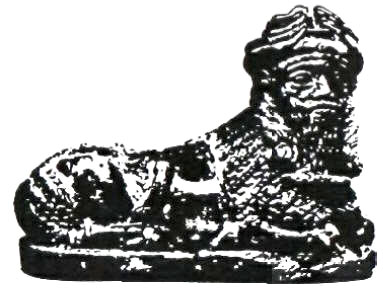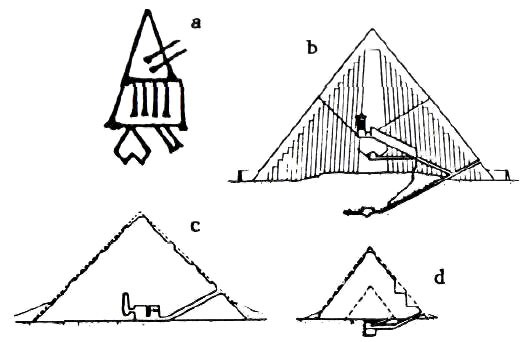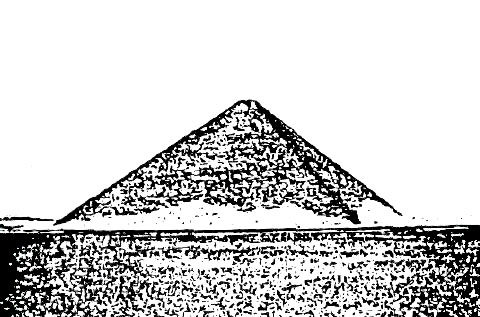|
There is a wealth of information in the inscriptions of Gudea; the more we study them and the special features of the Eninnu he built, the more astounded we shall be. Perusing the texts verse by verse and visualizing the great new temple-terrace and its ziggurat, we shall discover amazing celestial features of the "Bond Heaven-Earth"; one of the earliest if not the very earliest association of a temple with the zodiac; the appearance of sphinxes in Sumer at a totally unexpected time; an array of links with Egypt and especially with one of its Gods; and a "mini-Stonehenge" in the Land Between the Rivers...
Let us begin with the first task Gudea undertook after the construction of the ziggurat was completed and the temple-terrace formed. It was the erection of seven upright stone pillars at seven carefully selected positions. Gudea, the inscription states, made sure that they be firmly erected: he "laid them on a foundation, on bases he erected them," The stelae (as scholars call these upright stones) must have been of great importance, for Gudea spent a full year in bringing the rough stone blocks, from which the uprights were carved to shape, from a distant source to Lagash; and another year to cut and shape them.
But then, in a frenzied effort that lasted a precise seven days during which the work was carried out without stopping, without rest, the seven stelae were set up in their proper places. If, as the information given suggests, the seven stelae were positioned in some astronomical alignment, then the speed becomes understandable, for the longer the setting up would have taken, the more misaligned the celestial bodies would have become.
Signifying the importance of the stelae and their position is the fact that Gudea gave each one a "name" made up of a long sacred utterance evidently related to the position of the stela (e.g. "on the lofty terrace," facing the "gate of the river-bank" or another one "opposite the shrine of Anu"). Although the inscription stated unequivocally (column XXIX line 1) that "seven stelae were erected" in those seven hectic days, the names of only six locations are given. In respect to one, presumably the seventh stela, the inscription states that it "was erected toward the rising sun."
Since by then all the required orientations of the Eninnu had already been fixed, starting with the divine instructions and the laying of the cornerstone by Ningishzidda, neither the six spread out stelae nor the seventh "erected toward the rising sun" were required for orienting the temple. Another, different purpose had to be the motive; the only logical conclusion is that it involved observations other than determining the Day of the Equinox (i.e. of the New Year) - some astronomical-calendrical observations of an unusual nature, justifying the great effort in obtaining and shaping the stelae and the haste in setting them up.
The enigma of these erected stone pillars begins with the question, why so many when two are enough to create a line of sight, say toward the rising Sun. The puzzle is engulfed by incredulity when we read on in the inscription the sensational statement that the six whose locations were named were placed by Gudea "in a circle." Did Gudea use the stelae to form a stonehenge - in ancient Sumer, more than five thousand years ago?
Gudea's inscription indicates, according to A. Falkenstein (Die Inschriften Gudeas von Lagash), the existence of an avenue or pathway which - as at Stonehenge! - could provide an unimpeded sightline. He noted that the stela which was "toward the rising Sun" stood at one end of a pathway or avenue called "Way to the high position." At the other end of this way was the Shugalam, the "High place whose awesomeness is great, where the Brilliance is raised."
The term SHU.GALAM meant, according to Falkenstein, "Where the hand is raised" - a high place from which a signal is given. Indeed, the Cylinder A inscription asserts that "At the radiant entrance of Shugalam, Gudea stationed a favorable image; toward the rising Sun, in the destined place, the emblem of the Sun he established." We have already discussed the functions of the Shugalam when Gudea had gone to it, in the old temple, to remove the mortar or mud that obstructed the view through it. It was, we found, "the place of the aperture, the place of determining."
There, the inscription stated, "Ninurta could see the repetitions" - the annual celestial cycle - "over his lands." The description brings to mind the ceiling aperture about which there was so much arguing on Mount Zaphon between Ba'al and the divine architect who came from Egypt to design the new temple in Lebanon. Some additional light on the enigmatic purpose of such a skylight or aperture in the ceiling can be obtained from the examination of the Hebrew term for such a contraption and its Akkadian roots.
It is Tzohar and appears just once in the Bible to describe the only aperture in the ceiling of the otherwise hermetically sealed Noah's Ark. The meaning, all agree, is "a ceiling window through which a beam of light can shine in." In modern Hebrew the term is also used to denote "zenith," the point in the sky directly overhead; and both in modern Hebrew and biblical texts the term Tzohora'im that derived from it meant and still means "midday," when the Sun is directly overhead. Tzohar was thus not just a simple aperture, but one intended to let a beam of the Sun shine into a darkened enclosure at a certain time of the day; spelled slightly differently, Zohar, the term acquired the meaning "brightness, brilliance."
All stem from the Akkadian, the mother tongue of all the Semitic languages, in which the words tzirru, tzurru meant "lighten up, shine" and "be high." At the Shugalam, Gudea wrote, he "fixed the image of the Sun." All the evidence suggests that it was a viewing device through which the rising Sun - undoubtedly on Equinox Day, to judge from all the data in the inscriptions - was observed to determine and announce the arrival of the New Year.
Was the concept underlying the structural arrangement the same as (possibly) the one on Mount Zaphon and (certainly) as at the Egyptian temples, where a beam of sunlight passed along the preselected axis to light up the Holy of Holies at sunrise on the prescribed day? In Egypt the Sun Temples were flanked by two obelisks (Fig. 84) which the pharaohs erected so that they might be granted long life; their function was to guide the Sun's beam on the prescribed day.
Fig. 84
E.A. Wallis Budge (The Egyptian Obelisk) pointed out that the pharaohs, such as Ramses II and Queen Hatshepsut, always set up these obelisks in pairs. Queen Hatshepsut even wrote her royal name (within a cartouche) between two obelisks (Fig. 85a) to imply that the Blessed Beam of Ra shone on her on the crucial day.
Scholars have noted that Solomon's Temple also had two pillars erected at its entrance (Fig. 85c); like the uprights at the Eninnu which were given names by Gudea, so were the two pillars named by Solomon:
While the meaning of the two names eludes scholars (the best assumption is "Yahweh makes firm" and "In him is strength"), the shape, height, and makeup of the pillars is described in the Bible (mainly I Kings chapter 7) in detail.
The two pillars were made of cast bronze, eighteen cubits {some twenty-seven feet) high. Each pillar supported a complex "headband" around which, as a crown, there was placed a corolla whose serrated top created seven protrusions; one of them (or both, depending on the way the verse is read) was "encircled by a cord twelve cubits long." (Twelve and seven are the predominant numbers in the Temple.)
The Bible does not state the purpose of these pillars, and theories have ranged from purely decorative or symbolic to a function akin to that of the pair of obelisks that flanked the entrances to the temples in Egypt. In this regard a clue is suggested by the Egyptian word for "obelisk," which was Tekhen. The term, Budge wrote, "was a very old word, and we find it in the dual in the Pyramid Texts which were written before the close of the VIth Dynasty."
As to the meaning of the word, which he did not know, he added: "The exact meaning of Tekhen is unknown to us and it is probable that the Egyptians had forgotten it at a very early period." This raises the possibility that the word was a foreign term, a "loanword" from another language or country, and we on our part believe that the source, of both the biblical Yakhin and the Egyptian Tekhen was the Akkadian root khunnu which meant "to establish correctly" as well as "to start a light" (or fire).
The Akkadian term may even be traced back to the earlier Sumerian term GUNNU which combined the meanings "daylight" with "tube, pipe." These linguistic clues sit well with earlier Sumerian depictions of temple entrances showing them flanked by pillars to which circular devices were attached (Fig. 85b).
Figures 85a, 85b, and 85c
These must have been the forerunners of all such pairs of uprights, pillars, or obelisks elsewhere, for they appear on the Sumerian depictions millennia before the others. The search for answers to the puzzle of these uprights is further assisted by examining the term used by Gudea in his inscriptions to describe the stone uprights.
He called all seven of them NE.RU - from which the Hebrew word Ner, meaning "candle," stems. Sumerian script evolved by the scribe's making wedge-like markings with a stylus on wet clay to emulate the original drawing of the object or action for which the sign stood. We find that the original pictograph for the term Neru was that of two - two, not one - pillars set upon stable bases with antenna-like protrusions (Fig. 86).
Fig. 86
Such paired pillars, guiding (actually or symbolically) the Sun's beam on a specific day were sufficient it only one solar position - equinoctial or solstitial - was involved. If such a single determination was intended at the Girsu, two stelae, in alignment with the Shugalam, would have suf-ficed. But Gudea set up seven of them, six in a circle and the seventh in alignment with the Sun. To form a line of sight, this odd pillar could have been positioned either in the circle's center, or outside of it in the avenue.
Either way, the outcome would indicate uncanny similarities to Stonehenge in the British Isles. Six outer or circumference points with one in the center would have created a layout (Fig. 87) that, as in Stonehenge II - belonging to the same time - provided alignments not only with the equinoxes but also with the four solstice points (midsummer sunrise and sunset, midwinter sunrise and sunset). Fig. 87
Since the Mesopotamian New Year was firmly anchored to the
equinoxes, resulting in ziggurats whose determining corner was
oriented to the east, an arrangement of stone pillars that
incorporated fixings of the solstices was a major innovation. It
also indicated a decisive "Egyptian" influence, for it was at
Egyptian temples that an orientation linked to the solstices was the
dominant feature - certainly by Gudea's time. Fig. 88
Since at Stonehenge the Aubrey Holes were part of phase I, the sightline could be easily determined by a viewer at hole 28 directing his gaze through a post inserted in hole 56, watching for the Sun to appear above the Heel Stone on the propitious day. Such a similarity in layouts would be even more significant than the first alternative, for - as we have reported earlier - the rectangle formed by the four Station Stones implied lunar observations in addition to the solar ones.
The realization of this rectangular arrangement led both Newham
and Hawkins to far-reaching conclusions regarding the sophistication of the planners of Stonehenge I. Byt since Stonehenge I
preceded the Eninnu by about seven centuries, the similarity would
have to imply that whoever had planned the layout of the seven
uprights in the Eninnu copied from whoever had planned Stonehenge I.
This second circle was
arranged as a "round crown for the new Moon" and consisted of
thirteen stones erected "like heroes in a net-work" - a most
figurative way, it seems to us, to describe a circle of upright
stones connected at the top by lintels to form a "network" akin to
the Trilithons at Stonehenge!
This too enhances the similarities: Gudea too hauled not one but two types of stones from a great distance,'' from the stone mountains" of Magan (Egypt) and Melukhah (Nubia), both in Africa. We read in the inscription on Cylinder A that it took a full year to obtain these stone blocks from "stone mountains which no [Sumerian] king had entered before," To reach them, Gudea "into the mountains made a way, and their great stones he brought out in blocks; shiploads of Hua stones and Lua stones."
Though the meaning of the names of the two types of stones remains undeciphered, their distant origin is clearly stated. Coming from two African sources, they were first transported by land via a new way made by Gudea, then carried by ships over sea routes to Lagash (which was connected to the Euphrates River by a navigable canal).
As at Salisbury Plain in the British Isles so was it in the Mesopotamian plain: stones hauled from afar, stones especially selected, set up in two circles. As at Stonehenge I, seven pillars played a key role; as in all the phases of Stonehenge in Lagash, too, a large megalith created the desired sightline toward the principal solar orientation. In both places a stone "computer" was created to serve as a solar-lunar observatory.
Were both, then, created by the same scientific genius, by the same Divine Architect - or were they simply the result of accumulated scientific traditions that found expression in similar structures'? While general scientific knowledge as applied to astronomy and the calendar undoubtedly played a role, the hand of a specific Divine Architect cannot be ignored. In earlier chapters we have pointed out the key difference in design between Stonehenge and all the other temples of the Old World: the former was based on circular formations to observe the heavens; the latter were all built with right angles (rectangular or square).
This difference is evident not only in the general plan of the other temples but also in the several instances where stone uprights were found, emplaced in a pattern suggesting an astronomical-calendrical function. An outstanding example was found at Byblos, on a promontory overlooking the Mediterranean Sea.
The Holy of Holies of its temple, square in shape, was flanked by upright stone monoliths. They were set up in alignments suggesting observations of equinoxes and solstices; but none were arranged in a circle. So apparently was the case at a Canaanite site, Gezer, near Jerusalem, where the discovery of a tablet inscribed with the full list of months and their agricultural activities may suggest the existence of a center for the study of the calendar.
There too a row of upright monoliths indicates the existence in antiquity of a structure perhaps akin to that at Byblos; the remaining uprights, standing in a straight line, belie any circular arrangement. The few known instances of monoliths arranged in a circle, somehow emulating the extraordinary circular arrangement at the Girsu, come to us from the Bible. Their rarity, however, points to a direct connection to Sumer in Gudea's time.
Knowledge of a circle of thirteen with an upright in the center emerges in the tale of Joseph, a great-grandson of Abraham, who kept annoying his eleven brothers by telling them of his dreams wherein they all bowed to him although he was the youngest. The dream that upset them most, leading them to get rid of him by selling him into slavery in Egypt, was the one in which, Joseph related, he saw "the Sun and the Moon and eleven stars bowing down to me," meaning his father and mother and eleven brothers.
Several centuries later, as the Israelites left Egypt for the Promised Land in Canaan, an actual stone circle - this time of twelve stones - was erected. In chapters 3 and 4 of the Book of Joshua the Bible describes the miraculous crossing of the Jordan River by the Israelites under the leadership of Joshua. As instructed by Yahweh, the heads of the twelve tribes erected twelve stones in the midst of the river; and as the priests carrying the Ark of the Covenant stepped into the waters and stood where the twelve stones were placed, the flow of the river's waters "was cut off" upstream and the dry river bed was exposed, enabling the Israelites to cross the Jordan on foot.
As soon as the priests carrying the Ark stepped off the stones and carried the Ark across, "the waters of the Jordan returned to their place and flowed over its banks as they did before." Then Yahweh ordered Joshua to take the twelve stones and erect them in a circle on the west side of the river, east of Jericho, as an everlasting commemoration of the miracle performed by Yahweh.
The place where the twelve stones were erected was since then known as Gilgal, meaning "Place of the Circle." Not only the establishment of the twelve-stone circle as a miraculous device is relevant here; so is the date of the event. We first learn in Chapter 3 that the time was "harvest time, when the waters of the Jordan overflow its banks." Then Chapter 4 is more specific: it was in the first month of the calendar, the month of the New Year; and it was on the tenth of that month - the very day on which the inauguration ceremonies were culminated in Lagash - that "the people left the Jordan and encamped at Gilgal, where Joshua erected the twelve stones brought up from the Jordan River."
These calendrical markers bear uncanny resemblance to similar data concerning the time when Gudea had erected the stone circles on the platform of the Girsu, after the Eninnu itself was completed. We read in the Gudea inscrip-tions that the day Ninurta and his spouse entered their new abode was the day when the harvest began in the land - matching the "harvest time" in the tale of Gilgal. Astronomy and the calendar converge in both tales, and both concern circular structures.
The emergence of traditions of stone circles among the descendants of Abraham can be traced, we believe, to Abraham himself and the identity of his father Terah. Dealing with the subject in great detail in The Wars of Gods and Men, we have concluded that Terah was an oracle priest of royal descent, raised and trained in Nippur.
Based on biblical data we have calculated that he was born in 2193 BC.; this means that Terah was an astronomer-priest in Nippur when Enlil authorized his son, Ninurta, to proceed with the building of the new Eninnu by Gudea. Terah's son Abram (later renamed Abraham) was born, by our calculations, in 2123 BC. and was ten years old when the family moved to Ur, where Terah was to serve as a liaison. The family stayed there until 2096 BC. when it left Sumer for the Upper Euphrates region (a migration that later led to Abraham's settlement in Canaan).
Abraham was by then well-versed in royal and priestly matters, including astronomy. Getting his education in the sacred precincts of Nippur and Ur just as the glories of the new Eninnu were talked about, he could not have missed learning of the wondrous stone circle of the Girsu; and this would explain the knowledge thereof by his descendants. Where did the idea of a circle as a shape appropriate to astronomical observations - a shape that is the most outstanding feature of Stonehenge - come from?
In our view, it came from the zodiac, the cycle of twelve constellations grouped around the Sun in the orbital plane (the Ecliptic) of the planets. Earlier this century archaeologists uncovered in the Galilee, in northern Israel, the remains of synagogues dating to the decades and centuries immediately following the destruction of the Second Temple in Jerusalem by the Romans (in a.d. 70).
To their surprise, a common feature of those synagogues was the decoration of their Moors with intricate mosaic designs that included the signs of the zodiac. As this one from a place called Bet-Alpha shows (Fig. 89), the number - twelve - was the same as nowadays, the symbols were the same as now in use, and so were the names: written in a script no different from that of modern Hebrew, they begin (on the east) with Taleh for ram, Aries, flanked by Shor (bull) for Taurus and Dagim (fishes) for Pisces, and so on in the very same order that we continue to employ millennia later. Fig. 89
This zodiacal circle of what the Akkadians called Man-zallu ("stations" of the Sun) was the source of the Hebrew term Mazalot, which came to denote "lucks." Therein lies the transition from the essential astronomical and calendrical nature of the zodiac to its astrological connotations - a transition that in time obscured the original significance of the zodiac and the role it played in the affairs of Gods and men. Last but not least was its wondrous expression in the Eninnu that Gudea built.
The notion has prevailed, in spite of the facts, that the concept, names, and symbols of the zodiac were devised by the Greeks, for the word is of Greek origin, meaning "animal circle." It is conceded that the inspiration for them may have come from Egypt, where the zodiac with its unaltered symbols, order, and names was certainly known (Fig. 90). Fig. 90
In spite of the
antiquity of some of the Egyptian depictions - including a magnificent
one in the temple at Denderah, of which more later - the zodiac did
not begin there. Studies such as the one by E.C. Krupp (In Search of
Ancient Astronomies) have emphatically stated that "all available
evidence indicates that the concept of the zodiac was not native to
Egypt; instead, it is believed that the zodiac was imported to Egypt
from Mesopotamia," at some unknown date. Greek savants, who had
access to Egyptian art and traditions, had also attested in their
writings that as far as astronomy was concerned, its knowledge came
to them from the "Chaldeans," the astronomer-priests of Babylonia.
Fig. 91
Almost two thousands years before the circular zodiac of Bet-Alpha, Near Eastern rulers, especially in Babylon, invoked their Gods on treaty documents; boundary stones (Kudurru) were emblazoned with the celestial symbols of these Gods - planets and zodiacs - within the heavenly circle, embraced by an undulating serpent that represented the Milky Way (Fig. 92). Fig. 92
The zodiac, however, was begun, as far as Mankind is concerned, in Sumer. As we have undisputably shown in The 12th Planet, the Sumerians knew of, depicted (Fig. 93a) and named the zodiacal houses exactly as we still do six thousand years later:
Overwhelming evidence demonstrates that the Sumerians were cognizant of the zodiacal ages - not only the names and images but the precessional cycle thereof - when the calendar was begun in Nippur, circa 3800 BC., in the Age of Taurus.
Willy Hartner, in his study titled "The Earliest History of the Constellations in the Near East" (Journal of Near Eastern Studies), analyzed the Sumerian pictorial evidence and concluded that numerous depictions of a bull nudging a lion (Fig. 93b, from the fourth millennium BC.) or a lion pushing bulls (Fig. 93c, from about 3000 BC.) are representations of the zodiacal time when the spring equinox, at which time the calendrical new year began, was in the constellation Taurus and the summer solstice occurred in the sign of Leo. Figure 93a, 93b, 93c
Alfred Jeremias (The Old Testament in the Light of the Ancient Near East) found textual evidence that the Sumerian zodiacal-calcndrical "point zero" stood precisely between the Bull and the Twins (Gemini), from which he concluded that the zodiacal division of the heavens - in-explicably to him - was devised even before the Sumerian civilization began, in the Age of Gemini. Even more puzzling to scholars has been a Sumerian astronomical tablet (VAT.7847 in the Berlin Vorderasiatisches Museum) that begins the list of zodiacal constellations with that of Leo - taking one back to circa 11000 BC., just about the time of the Deluge.
Devised by the Anunnaki as a link between Divine Time (the cycle based on the 3,600 years orbit of Nibiru) and Earthly Time (the Earth's orbital period), the Celestial Time (the time span of 2,160 years for the precessional shift from one zodiacal House to another) served to date major events in Earth's prehistory as archaeoastronomy could do in historical times.
Thus, a depiction of the Anunnaki as astronauts and a spacecraft coursing between Mars (the six-pointed star) and Earth (identified by the seven dots and the accompanying crescent of the Moon) places the event, time-wise, in the Age of Pisces by including the zodiacal symbol of the two fishes in the depiction (Fig. 94). Written texts also included zodiacal dates; a text placing the Deluge in the Age of Leo is one example. Figure 94
Even if we cannot be certain precisely when Mankind was made aware of the zodiac, clearly it was long before Gudea's time. Hence it should not surprise us to discover that zodiacal depictions were indeed present in the new temple in Lagash; not, however, on the floor as in Bet-Alpha, and not as symbols carved on boundary stones.
Rather, in a magnificent structure that can rightly be called the first and most ancient planetarium! We read in Gudea's inscriptions that he emplaced "images of the constellations" in a "pure and guarded place, in an inner sanctuary." There, a specially designed "vault of heaven " - an imitation of the heavenly circle, a kind of ancient planetarium - was built as a dome resting on what is translated as ''entablature" (a technical term meaning a base of a superstructure resting atop columns).
In that "vault of heaven" Gudea "caused to dwell" the zodiacal images. We find clearly listed the "Heavenly Twins," the "Holy Capricorn," the "Hero" (Sagittarius), the Lion, the "Celestial Creatures" of the Bull and the Ram. As Gudea had boasted, that "vault of heaven" studded with the zodiacal symbols must indeed have been a sight to behold.
Millennia later, we can no longer step into that inner sanctum and share with Gudea the illusion of viewing the heavens with their shimmering constellations; but we could have gone to Denderah, in Upper Egypt, entered there the inner sanctum of its principal temple, and looked up to the ceiling. There we could have seen a painting of the starry heavens: the celestial circle, held up at the four cardinal points by the Sons of Horus and at the four points of solstitial sunrise and sunset by four maidens (Fig. 95). Figure 95
A circle
depicting the thirty six "decans" (ten-day periods, three per month,
of the Egyptian calendar) surrounds the central "vault of heaven"
in which the twelve zodiacal constellations are depicted by the same
symbols (bull, ram, lion, twins, etc.) and in the same order that we
still use and that was begun in Sumer. The hieroglyphic name of the
temple, Taynt neterti, meant "Place of the pillars of the Goddess,"
suggesting that at
Denderah too, as in the Girsu, stone uprights
served for celestial observations, connected on the one hand to the
zodiac and on the other hand to the calendar (as the thirty-six
decans attest).
Scholars are, however, certain that it replicated a similar depiction in a much earlier temple, one that was dedicated to the Goddess Hathor. Sir Norman Lockyer in The Dawn of Astronomy interpreted a Fourth Dynasty (2613-2494 BC.) text as describing the celestial alignments in that earlier temple; this would date the Denderah "vault of heaven" to a time between the completion of Stonehenge I and the building of the Eninnu in Lagash by Gudea.
If, as others hold, the skies shown in Denderah are dated by the image of the club topped by a falcon touching the foot of the Twins (Gemini), between the Bull (Taurus) on the right and the Crab (Cancer) on the left, it means that the Denderah depiction turned back the skies (as we do in modem planetariums when, say, at Christmas time the skies are shown as they were in the time of Jesus) to sometime between 6540 BC. and 4380 BC.
According to the Egyptian chronology transmitted by the priests and recorded by Manetho, that was the time when demigods reigned over Egypt; such a dating of the Denderah skies (as distinct from when the temple itself was built) corroborates the findings, mentioned above, by Alfred Jeremias regarding the "point zero" of the Sumerian zodiacal calendar.
Both Egyptian and Sumerian zodiacal datings thus confirm that the concept preceded the start of those civilizations, and that the "Gods," not men, were responsible for the depictions and their dating. Since, as we have shown, the zodiac and its accompanying Celestial Time were devised by the Anunnaki soon after they first came to Earth, some of the zodiacal dates marking events depicted on cylinder seals do stand for zodiacal ages that preceded the emergence of Man's civilizations.
The Age of Pisces, for example, that is indicated by the two fishes on Fig. 94, occurred no later than between 25980 BC. and 23820 BC. (or earlier if the event had taken place at prior ages of Pisces in the Great Cycle of 25,920 years). Incredibly but not surprisingly, we find a suggestion that a "starry heaven" depicting the celestial circle with the constellations of the zodiac might have existed in the earliest times in a Sumerian text known to scholars as A Hymn to Enlil the All-Beneficent.
Describing the innermost part of Enlil's Mission Control Center in Nippur, inside the E.KUR ziggurat, the text states that in a darkened chamber called Dirga there was installed "a heavenly zenith, as mysterious as the distant sea" in which "the starry emblems" were "carried to perfection." The term DIR.GA connotes "dark, crownlike"; the text explains that the "starry emblems" installed therein enabled the determination of festivals, meaning a calendrical function. It all sounds like a forerunner of Gudea's planetarium; except that the one in the Ekur was hidden from human eyes, open to the Anunnaki alone.
Gudea's '' vault of heaven,'' constructed as a planetarium, bears a greater similarity to the Dirga than to the depiction at Denderah, which was only a painting on the ceiling. Yet we cannot rule out the possibility that the inspiration for the one in the Girsu came from Egypt because of the numerous similarities to Egyptian ones that features in the Girsu bore.
The list is far from being exhausted. Some of the most impressive finds now adorning the Assyrian and Babylonian collections in the major museums are colossal stone animals with bodies of bulls or lions and heads of Gods wearing horned caps (Fig. 96) that stood as guardians at temple entrances. Figure 96
We can safely assume that these "mythical creatures," as scholars call them, translated into stone sculptures the Bull-Lion motif that we illustrated earlier, thereby invoking for the temples the magic of an earlier Celestial Time and the Gods associated with its past zodiacal ages. Archaeologists believe that these sculptures were inspired by the sphinxes of Egypt, primarily the great Sphinx of Giza, with which the Assyrians and Babylonians were familiar as a result of both trade and warfare.
But the Gudea inscriptions reveal that some fifteen hundred years before such zodiacal-cum-divine creatures were emplaced in As-syrian temples, Gudea had already positioned sphinxes at the Eninnu temple; the inscriptions specifically mention "a lion that instilled terror" and a "wild ox, massively crouching like a lion."
To the archaeologists' utter disbelief that sphinxes could have been known in ancient Sumer, a statue of Ninurta/Ningirsu himself, depicting him as a crouching sphinx (Fig. 97), was discovered among the ruins of the Girsu in Lagash.
Figure 97
Hints that all that should have been expected were given to Gudea - and thus to us - in the address by Ninurta to the baffled Gudea during the second night vision, in which Ninurta asserted his powers and reasserted his standing among the Anunnaki ("By fifty edicts my lordship is ordained"), pointed out his unusual familiarity with other parts of the world ("A lord whose eyes are lifted up afar" as a result of his roamings in his Divine Black Bird), assured him of the cooperation of Magan and Meiukhah (Egypt and Nubia), and promised him that the God called "the Bright Serpent" will, in person, come to assist in the construction of the new Eninnu: ''As a strong place it shall be built, like E.HUSH will my holy place be."
This last statement is truly sensational in its implications. "E" as we already know meant a God's "house," a temple; and in the case of the Eninnu - a stage-pyramid. HUSH (pronounced "Chush" with the "ch" as in the German Loch) meant in Sumerian "of reddish hue, red-colored." So this is what Ninurta/Ningirsu stated: the new Eninnu will be like the "Red-hued Divine House."
The statement implies that the new Eninnu will emulate an existing structure known for its reddish hue... Our search for such a structure can be facilitated by tracing back the pictograph for the sign Hush. What we find is truly astounding, for what it amounts to (Fig. 98a) is a line drawing of an Egyptian pyramid showing its shafts, internal passages, and subterranean chambers.
More specifically, it appears to be drawn as a cross section of the Great Pyramid of Giza (Fig. 98b) and its trial scale model, the small pyramid of Giza (Fig. 98c) - and of the first successful pharaonic pyramid (Fig. 98d) which, quite significantly - was called the Red Pyramid, of the very same hue that Hush had meant.
Figures 98a, 98b, 98c, and 98d
The Red Pyramid was certainly there to be emulated when the Eninnu was built in Lagash. It was one of three pyramids attributed to Sneferu, the first pharaoh of the IV dynasty, who reigned circa 2600 BC.
His architects first attempted to build for him a pyramid at Maidum, emulating the 52° slope of the Giza pyramids that were built millennia earlier by the Anunnaki; but the angle was too steep and the pyramid collapsed. The collapse led to a hurried change in the angle of a second pyramid at Dahshur to a flatter 43°, resulting in the pyramid nicknamed the Bent Pyramid. This led to the construction, also at Dahshur, of the third Sneferu pyramid.
Considered the "first classical pyramid" of a pharaoh, its sides slope up at the safe angle of about 43½º (Fig. 99). It was built of local pink limestone and was therefore nicknamed the Red Pyramid.
Figure 99
Protrusions on the sides were intended to hold in place a surfacing of white limestone; but that did not stay put for long, and today the pyramid is seen in its original reddish hue. Having fought (and won) the Second Pyramid War in Egypt, Ninurta was not unfamiliar with its subsequent pyramids.
Had he seen, as kingship came to Egypt, not only the Great Pyramid and its companions at Giza, but also the step-pyramid built by the Pharaoh Zoser at Sakkara, surrounded by its magnificent sacred precinct (see Fig. 78), built circa 2650 BC.? Had he seen the final successful emulation by a pharaoh and his architects of the Great Pyramid - the Red Pyramid of Sneferu, built circa 2600 BC.? And did he then tell the Divine Architect: that is what I would like to have built for me, a unique ziggurat combining elements of all three?
Else, how can one account for the compelling evidence linking the Eninnu, built between 2200 and 2100 BC., with Egypt - and its Gods? And how else, except in this way, can one explain the similarities between Stonehenge in the British Isles and "Stonehenge on the Euphrates"?
For the explanation we have to turn our attention to the Divine Architect, the Keeper of the Secrets of the Pyramids, the God called by Gudea Ningishzidda; for he was none other than the Egyptian God Tehuti whom we call THOTH. Thoth was called in the Pyramid Texts "He who reckons the heavens, the counter of the stars and the measurer of the Earth"; the inventor of arts and sciences, scribe of the Gods, the "One who made calculations concerning the heav ens, the stars and the Earth."
As the "Reckoner of times and of seasons," he was depicted with a symbol combining the Sun's disk and the Moon's crescent upon his head, and - in words reminiscent of the biblical adoration of the Celestial Lord - the Egyptian inscriptions and legends said of Thoth that his knowledge and powers of calculating "measured out the heavens and planned the Earth." His hieroglyphic name Tehuti is usually explained as meaning "He who balances."
Heinrich Brugsch (Religion und Mythologie) and E.A. Wallis Budge (The Gods of the Egyptians) interpreted that to mean that Thoth was the "God of the equilibrium" and considered depictions of him as "Master of the Balance" to indicate that he was associated with the equinoxes - the time when the day and the night were balanced.
The Greeks identified Thoth with their God Hermes, whom they considered to have been the originator of astronomy and astrology, of the science of numbers and of geometry, of medicine and botany. As we follow in the footsteps of Thoth, we shall come upon calendar tales that raise the curtain on the affairs of Gods and men - and on enigmas such as Stonehenge.
|
